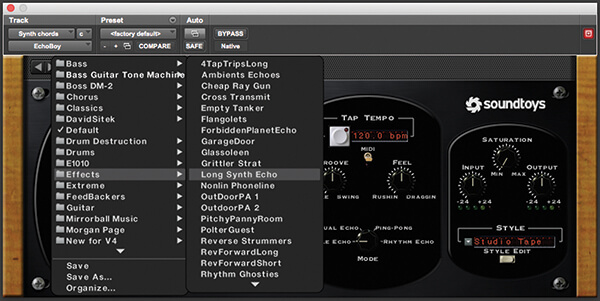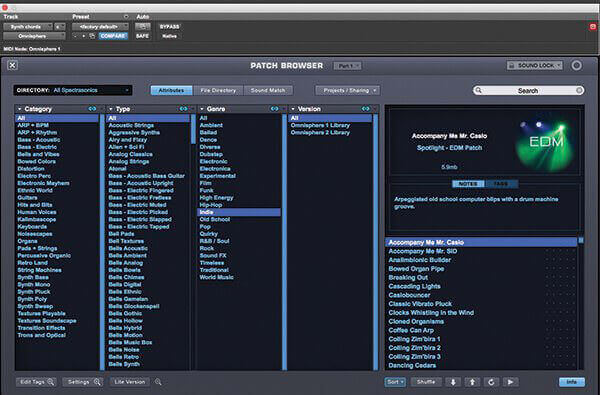In Defense of Presets
And How to Incorporate Them Into Your Studio Sessions
A TIME & PLACE FOR EVERYTHING
Life is too full to do everything, all the time. Ultimately, even within music, you’ll have to define yourself by what you do best and most love to do. For me, that’s producing and mixing music for my clients. For others, that may be recording, writing jingles, performing, songwriting, or sound design.
What you do will likely dictate how you do it. A songwriter may work well at a coffee shop, but it would be hard to mix in that environment. Similarly, a great studio is well suited to mixing or recording, but probably not an ideal place to write songs. In the middle of a mix session when a sound needs to be replaced, or when producing with a client, isn’t the best time to stop and dive into the deep waters of making a new sound from scratch.
WHAT ARE PRESETS?
Presets provide a partial solution to this workflow problem. Presets are the sounds that come already loaded with hardware and software devices. Time was that they were uniformly lousy, but were included to show a glimpse of what that device could do. We all remember the horrible “built-in song” that came with the keyboard we just bought. As a result, many of us were convinced that presets were “non-musical,” lazy, or required a talentless person to use. A hardcore mentality arose in which all sounds had to be invented, on the spot, to be considered worthy.

It turns out that some music folk just love to tweak parameters and invent new sounds! That’s their “thing.” We should be deeply grateful for those sorts of musicians. They have swollen the ranks of sound designers, a field once reserved for oddball synthetists and Foley artists wielding coconut shells.
KNOB-TWEAKING & HOW TO USE PRESETS
I’ve had interns over the years who just loved this tweaking. Many have turned out not to be the engineers they sought to be, but have come to recognize their love of sound design and have successfully pointed their career in that direction. Couple those sound designers with the ever increasing power of computers, and the virtual world has allowed manufacturers to go well beyond those embarrassing “songs” and provide deep banks of pre-made sounds.
As professionals, then, we have to re-evaluate our hardcore notion of what presets are and how to use them. There’s really good stuff in there! On the other hand, we all still hear productions all day long that use the same sounds over and over again. Clearly there must be a middle ground that is neither a showstopper for the workflow nor boring, lazy, and talentless.
I use presets as a starting point. Maybe I’m looking for a particular kind of sound, or maybe I’m looking for inspiration. A preset gets me “in the ballpark.” From there, it’s not hard or time-consuming to figure out what needs changing. Perhaps the LFO needs to be sync’d to MIDI, or the waveform of that LFO needs to be a triangle instead of a sine. Maybe the modulation and delay are perfect, but the oscillator or the wavetable needs to be altered. Whatever it is, it’s quick and easy from the starting point of the preset.

WHEN NOT TO USE PRESETS
There are processors that I won’t use from a preset: compressors and EQ. Arguably these are in a different category, they’re less “effects” and more about shaping tone (see my columns from June and July 2015 for more). In those cases, the outcome is so dependent on the starting audio that a preset isn’t really helpful. Those devices just need you to understand them, and use your ears.
Ultimately, it comes down to getting the work done, and the art made. How you get there depends on your preferences, talent, and workflow. I always say, “If it sounds good, it is good,” meaning it doesn’t matter how you got there, so long as it’s undeniably good. Sound designers love to tweak and tweak, and I thank them for having a different set of skills and desires than I. My clients hire me to make them sound great. That’s my thing. Presets, carefully designed by those happy tweakers, and tweaked further by me on-the-fly, help me make my clients happy.
ABOUT THE AUTHOR
Award winning mix engineer and producer Jordan Tishler runs Digital Bear Entertainment in Boston MA. A large Augsburger designed mix/overdub room with SSL console and racks upon racks of analogue outboard gear, tape machine, and gazillions of instruments, Tishler has credits including B Spears, JLo, Iggy A, MOTi, Justin Prime, SIA, and London Grammar. Contact me about producing your next record, or mixing the one you’re working on now! For more, visit www.digitalbear.com.
